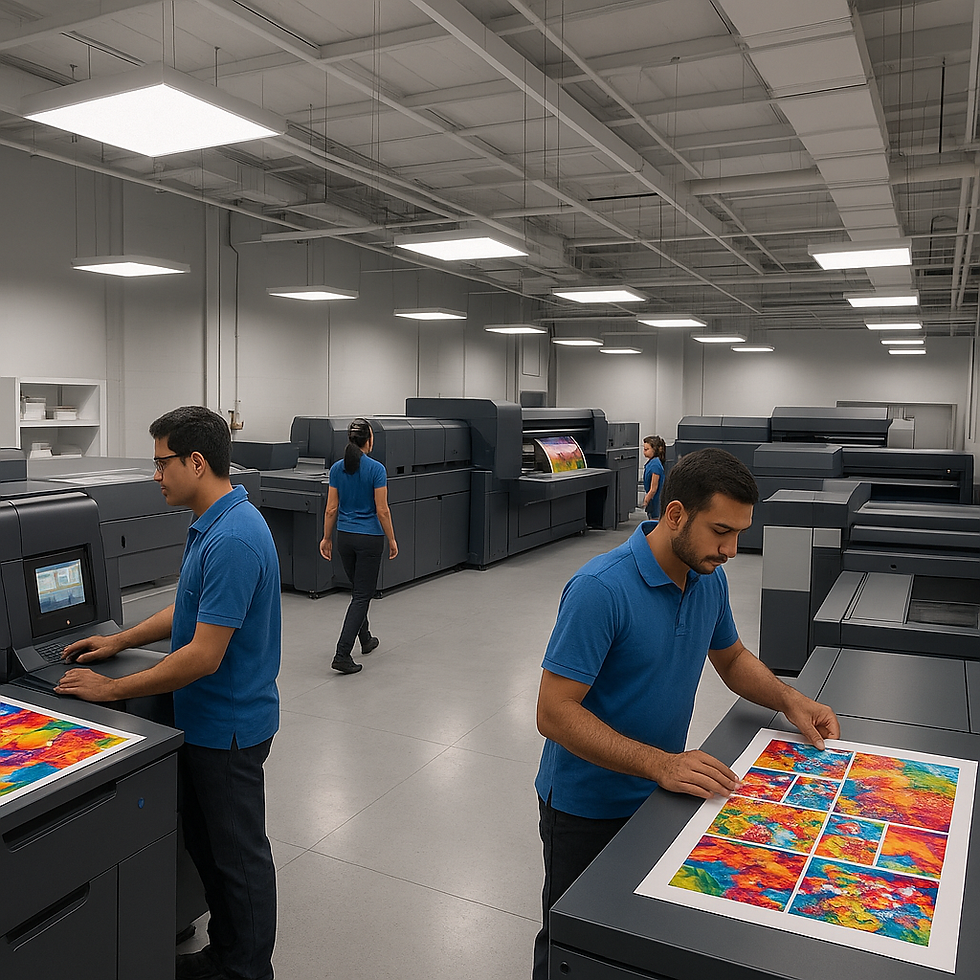Understanding the Basics of Color Models in Printing
- cmyk graphics
- Jun 22
- 4 min read
Color is an essential aspect of design, influencing how we perceive and interact with visual media. Understanding color models is crucial, especially in printing, as it allows designers and print professionals to communicate their ideas effectively. This blog post will explore the basics of color models, focusing on their significance, the most common types, and practical applications in the printing world.
What are Color Models?
A color model is a standardized way to represent colors in a digital or physical format. It provides a framework for creating, identifying, and reproducing a wide range of colors. By understanding color models, designers can ensure that their prints look as intended, whether on paper or fabric.
Different industries may utilize various color models. For example, the RGB model is frequently used for digital screens, while the CMYK model is the standard for printing. Each model represents colors differently and is essential in producing accurate and vibrant print outputs.

Key Color Models
Several key color models cater to different applications. Let's take a closer look at the most commonly used models: RGB, CMYK, and HSL.
RGB Color Model
The RGB (Red, Green, Blue) color model is the foundation of digital color. It combines varying intensities of red, green, and blue light to create other colors. The RGB model is additive, meaning that when combined at full strength, the result is white light.
In practical terms, RGB is primarily used for screens, such as computer monitors and televisions. When designing graphics for digital media, it's essential to work in the RGB color model to ensure the colors display correctly.

CMYK Color Model
The CMYK (Cyan, Magenta, Yellow, Key/Black) color model is the go-to choice for printing. Unlike the additive RGB model, CMYK is subtractive. This means that when colors are mixed, the resulting color gets darker, eventually leading to black when combined at full strength.
CMYK printing relies on ink layering to create various shades and hues. By varying the amount of each color in the printing process, printers can achieve a wide spectrum of colors. Because of how ink is applied, it’s vital for designers to understand the limitations and characteristics of CMYK, especially when converting from RGB to ensure high-quality prints. For more information about the nuances of CMYK printing, check out cmyk printing.
HSL Color Model
The HSL (Hue, Saturation, Lightness) color model presents colors in a more intuitive way for many designers. Hue refers to the color itself, saturation indicates the intensity or purity of the color, and lightness denotes how light or dark the color appears.
HSL is often used in graphic design software as it allows designers to make adjustments to colors in a more visual manner. For instance, it’s easy to create pastel shades by lowering saturation or brightness while keeping the hue constant.
The Importance of Color Models in Printing
Understanding color models is crucial for anyone involved in the design or printing process. Here are several reasons why:
Accurate Color Representation
Different devices and materials can distort color representation. By using the correct color model and calibration techniques, designers can ensure their work is consistently represented across different mediums.
Better Communication
When designers, clients, and printers share color information, they refer to specific color models. Clear understanding enables better communication and reduces the risk of errors in the final print.
Efficiency in Workflows
Familiarity with color models allows designers to streamline their workflows. Knowing how to convert colors between models effectively means less time spent troubleshooting and adjusting colors before printing.

Practical Applications of Color Models
When it comes to applications, different fields utilize color models in unique ways.
Graphic Design
Graphic designers use color models extensively when creating digital or print media. Using the RGB model for digital designs and ensuring the final output translates well into the CMYK model for print is a critical step in the design process.
Fashion and Textiles
In fashion, colors play a massive role in influencing trends and consumer behavior. Designers often rely on color models to select fabric colors that will correspond with their original designs, ensuring consistency from concept to finished product.
Web Design
Web designers must consider color models when creating websites. Colors that appear vivid on screens using the RGB model may not translate well in print. Thus, choosing compatible colors between both models can enhance user experience and maintain brand consistency.
Best Practices for Working with Color Models
To effectively work with color models, consider the following best practices:
Calibrate Your Monitor: Regularly calibrate your screen to ensure accurate color representation. This ensures that the colors you see on screen will translate well into the model that will be applied in print or web format.
Use Color Books: Reference physical color books, such as Pantone guides, to select standardized colors. These resources offer a reliable way to ensure accurate communication with printers and manufacturers.
Understand Color Limits: Be aware of the limitations of color models. For instance, certain colors created in RGB may not be reproducible in the CMYK model due to the subtractive process used in printing.
Test Prints: Always opt for test prints before final runs. Different materials and finishing methods can affect how colors look, so a test can catch discrepancies early on.
Stay Updated: Lastly, as technology evolves, so do color models and printing techniques. Continuously educating yourself on the latest trends and tools will contribute to higher quality and more efficient design projects.
Exploring Future Trends in Color Models
As technology advances, so does the landscape of color models. Here are a few emerging trends to consider:
Digital Color Calibration
With the increasing reliance on digital formats, better color calibration tools and software will emerge. These innovations will streamline the transition between RGB to CMYK and ensure consistency across all platforms.
New Color Models
Researchers are continuously exploring new ways to describe and reproduce colors. Innovations may introduce new models that provide enhanced accuracy and creativity for designers, especially as printing technologies become more diverse.
Sustainability in Printing
As sustainability becomes a primary concern across industries, color models may adapt by focusing on eco-friendly inks and printing materials. This evolution will influence how colors are represented and applied in both the design and printing processes.
Understanding the basics of color models in printing is essential for anyone working in design and production. By grasping how different models work, applying best practices, and staying ahead of industry trends, you can enhance your creative projects and ensure accurate and impactful color representation.





Kommentare